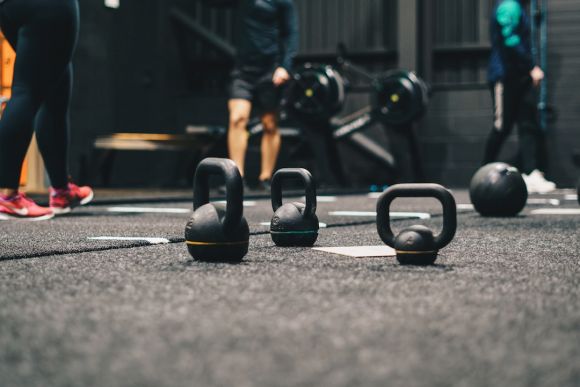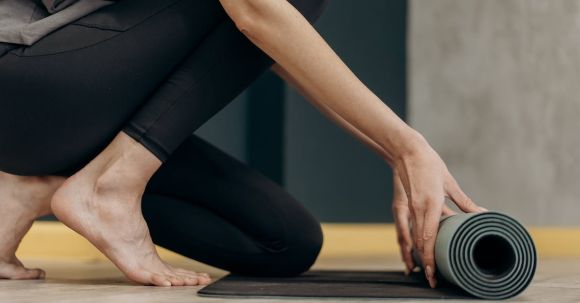Yoga has become increasingly popular in recent years, and for good reason. It offers a wide range of physical and mental benefits, making it a great addition to any fitness routine. If you've been curious about trying yoga but aren't sure how to incorporate it into your current workout regimen, look no further. In this article, we will explore some simple and effective ways to seamlessly blend yoga into your fitness routine.
Fitness tips and advice
When it comes to exercise, there are many options to choose from. From cardio workouts to yoga classes, the possibilities are endless. However, one form of exercise that often gets overlooked is resistance training. Incorporating resistance training into your routine can have numerous benefits for your overall health and fitness. In this article, we will explore some of these benefits and why you should consider adding resistance training to your workout regimen.
Improved Muscle Strength and Tone
One of the primary benefits of resistance training is improved muscle strength and tone. By using resistance, such as weights or resistance bands, you are challenging your muscles to work harder. Over time, this leads to an increase in muscle strength and definition. Resistance training can target specific muscle groups, allowing you to focus on areas that you want to tone and strengthen. Whether it's your arms, legs, or core, resistance training can help you achieve the sculpted physique you desire.Increased Bone Density
Another advantage of resistance training is increased bone density. As we age, our bones naturally become weaker and more prone to fractures. However, resistance training can help combat this. When you perform weight-bearing exercises, such as squats or lunges, you are putting stress on your bones. This stress stimulates the production of new bone cells, leading to increased bone density. By incorporating resistance training into your routine, you can help prevent conditions like osteoporosis and maintain strong, healthy bones.Boosted Metabolism
Resistance training can also have a positive impact on your metabolism. Unlike cardio exercises that primarily burn calories during the workout itself, resistance training can help increase your metabolic rate even after you've finished exercising. This is because resistance training builds lean muscle mass, which requires more energy to maintain. The more lean muscle mass you have, the higher your basal metabolic rate. This means that your body will burn more calories at rest, making it easier to maintain a healthy weight and body composition.Improved Mental Health
Exercise has long been known to have positive effects on mental health, and resistance training is no exception. When you engage in resistance training, your body releases endorphins, also known as "feel-good" hormones. These endorphins can help improve your mood, reduce stress, and alleviate symptoms of anxiety and depression. Additionally, resistance training can boost your self-confidence and body image, leading to improved overall mental well-being.Enhanced Functional Fitness
Resistance training can also improve your functional fitness, which refers to your ability to perform everyday tasks with ease. By incorporating exercises that mimic real-life movements, such as squats, lunges, and deadlifts, you can improve your strength and stability in a way that directly translates to everyday activities. Whether it's carrying groceries, climbing stairs, or playing with your kids, resistance training can help you perform these tasks more efficiently and with less risk of injury.Incorporating Resistance Training into Your Routine
Now that you understand the benefits of resistance training, you may be wondering how to incorporate it into your routine. The good news is that there are numerous ways to do so. You can join a gym and use weight machines or free weights, take a resistance training class, or even incorporate bodyweight exercises into your home workouts. It's important to start slowly and gradually increase the intensity and resistance as your strength improves. In conclusion, resistance training offers a multitude of benefits for your physical and mental well-being. From improved muscle strength and tone to increased bone density and a boosted metabolism, the advantages are clear. So why not give it a try? Incorporate resistance training into your routine and reap the rewards of a stronger, healthier body.
In today's fast-paced world, finding time for exercise can be a challenge. Between work, family, and other commitments, our schedules are often packed. However, it's important to prioritize our health and fitness, even when time is limited. Fortunately, there are quick and effective workouts that can be done in a short amount of time, allowing you to stay active and fit, no matter how busy you are.
1. HIIT (High-Intensity Interval Training)
HIIT workouts are perfect for busy individuals who want to maximize their workout in a short amount of time. This type of training involves short bursts of intense exercise followed by brief periods of rest. The high-intensity intervals get your heart rate up and burn calories, while the rest periods give you a chance to recover. HIIT workouts can be done in as little as 20 minutes and can be tailored to your fitness level and preferences.2. Tabata Training
Similar to HIIT, Tabata training is a form of high-intensity interval training that follows a specific structure. It consists of 20 seconds of all-out effort followed by 10 seconds of rest, repeated for a total of four minutes. This short but intense workout can be done with various exercises, such as squats, push-ups, or burpees. Tabata training is a quick and efficient way to improve cardiovascular fitness and build muscle strength.3. Circuit Training
Circuit training is a versatile workout that combines strength and cardiovascular exercises into a series of stations. You move quickly from one exercise to the next, with little to no rest in between. This type of workout can be customized to target specific muscle groups or overall body conditioning. Circuit training is time-efficient, as it allows you to work multiple muscle groups simultaneously and keeps your heart rate elevated throughout the workout.4. Bodyweight Exercises
Bodyweight exercises are an excellent option for busy schedules, as they require no equipment and can be done anywhere. These exercises use your own body weight as resistance, making them effective for building strength and endurance. Push-ups, squats, lunges, planks, and burpees are just a few examples of bodyweight exercises that target multiple muscle groups. You can create a quick and effective workout by combining different bodyweight exercises and performing them in a circuit or interval format.5. Mini Workouts Throughout the Day
If finding a dedicated block of time for exercise is a challenge, consider incorporating mini workouts into your daily routine. These short bursts of activity can add up throughout the day and provide numerous health benefits. For example, you can do a set of squats while waiting for your coffee to brew or take the stairs instead of the elevator. Even a few minutes of exercise here and there can make a difference in your fitness level and overall well-being.Conclusion: Prioritize Your Health
Although it may seem difficult to fit exercise into a busy schedule, it's essential to prioritize your health and make time for physical activity. Quick and effective workouts, such as HIIT, Tabata training, circuit training, and bodyweight exercises, can help you stay active and fit even when time is limited. Additionally, incorporating mini workouts throughout the day can provide numerous health benefits. With a little creativity and determination, you can find ways to stay active and maintain a healthy lifestyle, no matter how busy you are.
Flexibility plays a crucial role in various activities, from sports and exercise to everyday tasks. Having good flexibility not only improves your performance but also reduces the risk of injuries. If you're looking to enhance your flexibility, here are some effective strategies to incorporate into your routine.
1. Stretch before and after exercise
Stretching is essential for improving flexibility. Before starting any physical activity, it's important to warm up your muscles with dynamic stretches. These stretches involve moving your body parts through a full range of motion. After your workout, perform static stretches to lengthen and relax your muscles. Hold each stretch for 15-30 seconds and repeat on both sides.2. Incorporate yoga into your routine
Yoga is a fantastic way to enhance your flexibility. The various poses in yoga focus on stretching and strengthening different muscle groups. Regular practice can improve your overall flexibility and range of motion. Consider joining a yoga class or following along with online tutorials to reap the benefits of this ancient practice.3. Use foam rollers or massage balls
Foam rollers and massage balls are excellent tools for targeting specific muscles and releasing tension. They work by applying pressure to different areas of your body, helping to improve flexibility and reduce muscle soreness. Incorporate foam rolling or self-massage into your routine, paying attention to areas that feel tight or restricted.4. Perform dynamic stretches daily
Dynamic stretches involve moving your body while stretching, and they are particularly effective in improving flexibility and mobility. Incorporate dynamic stretches into your daily routine, focusing on areas that need extra attention. Examples of dynamic stretches include leg swings, arm circles, and torso twists.5. Practice deep breathing techniques
Deep breathing techniques not only promote relaxation but also enhance flexibility. When you take slow, deep breaths, you allow your muscles to relax and stretch more effectively. Incorporate deep breathing exercises into your stretching routine to maximize the benefits.6. Gradually increase your range of motion
Improving flexibility takes time and patience. It's crucial to gradually increase your range of motion to avoid overstretching or injuring yourself. Start with gentle stretches and gradually push yourself a little further each time. Listen to your body and stop if you feel any pain or discomfort.7. Stay consistent with your stretching routine
Consistency is key when it comes to improving flexibility. Set aside dedicated time each day to focus on stretching and mobility exercises. By making it a habit, you'll see significant improvements in your flexibility over time.8. Seek professional guidance
If you're unsure about the best stretching techniques or have specific flexibility goals, consider seeking guidance from a professional, such as a personal trainer or physical therapist. They can assess your current flexibility levels and develop a personalized stretching routine to help you achieve your goals safely and effectively.9. Incorporate strength training into your routine
Strength training exercises, such as weightlifting or resistance training, can also improve flexibility. As you build strength in your muscles, it becomes easier to perform stretches and increase your range of motion. Include strength training exercises that target your major muscle groups to complement your flexibility routine.10. Listen to your body
Lastly, always listen to your body. If a stretch feels uncomfortable or painful, modify it or choose a different stretch altogether. Flexibility is a journey, and it's essential to prioritize safety and avoid pushing your body beyond its limits. In conclusion, improving flexibility is essential for better performance in various activities. By incorporating these strategies into your routine, you can enhance your flexibility, reduce the risk of injuries, and ultimately achieve your fitness goals. So, start stretching and enjoy the benefits of a more flexible body.
Working out at home has become increasingly popular, especially in light of recent events that have limited our access to gyms and fitness centers. While it may seem convenient and easy to workout at home, staying motivated can be a challenge. Without the structure and energy of a gym environment, it's easy to get distracted or lose motivation. However, with a few simple tips, you can stay motivated and make the most out of your home workouts.
Create a Dedicated Workout Space
One of the most important factors in staying motivated when working out at home is to create a dedicated workout space. By designating a specific area in your home for exercise, you create a physical and mental separation between your workout time and the rest of your daily activities. This space can be a spare room, a corner in your living room, or even just a yoga mat on the floor. Whatever it may be, make sure it is free from distractions and has enough room for you to move comfortably.Set Clear and Achievable Goals
Having clear and achievable goals is crucial for maintaining motivation. Whether you want to lose weight, build muscle, or improve your overall fitness level, setting specific goals will give you something to work towards. Break down your goals into smaller, manageable milestones, and celebrate your progress along the way. This will help you stay focused and motivated, as you will have a sense of accomplishment every time you reach a milestone.Mix Up Your Routine
Doing the same workout routine day after day can quickly become monotonous and boring. To stay motivated, it's important to mix up your routine and keep things interesting. Try different types of workouts, such as HIIT, yoga, or dance cardio. You can also vary the intensity, duration, or equipment used in your workouts. By constantly challenging yourself and trying new things, you'll keep your workouts fresh and exciting.Find a Workout Buddy
Working out alone at home can be isolating and uninspiring. Finding a workout buddy, either in person or virtually, can greatly enhance your motivation. Having someone to exercise with can provide accountability and support. You can encourage each other, share workout ideas, and even compete in friendly challenges. Additionally, working out with a buddy can make your workouts more enjoyable and social, even if you're not physically together.Use Technology to Your Advantage
Technology can be a powerful tool for staying motivated when working out at home. There are countless fitness apps, online classes, and streaming platforms that offer a wide variety of workouts. Find one that suits your interests and needs, and use it as a source of inspiration and guidance. You can also track your progress, set reminders, and join virtual fitness communities to stay connected and motivated.Reward Yourself
Rewarding yourself for your hard work and dedication can be a great way to stay motivated. Set small rewards for yourself when you reach certain milestones or achieve your goals. It could be treating yourself to a massage, buying new workout gear, or indulging in a favorite healthy snack. By acknowledging your progress and treating yourself, you'll stay motivated and continue to push yourself towards your fitness goals. In conclusion, staying motivated when working out at home can be a challenge, but with the right strategies, it is entirely possible. By creating a dedicated workout space, setting clear goals, mixing up your routine, finding a workout buddy, utilizing technology, and rewarding yourself, you can stay motivated and make the most out of your home workouts. Remember, consistency is key, so keep pushing yourself and stay committed to your fitness journey.
Staying motivated while working out alone can be a challenge. Without the support and energy of a workout buddy or a group class, it's easy to lose focus and momentum. However, with the right strategies and mindset, you can stay motivated and reach your fitness goals. Here are some tips to help you stay on track when working out alone.
1. Set Clear Goals
Setting clear and specific goals is essential to staying motivated. Instead of simply saying, "I want to get in shape," be specific about what you want to achieve. Whether it's losing a certain amount of weight, running a 5k, or increasing your strength, having a clear goal in mind will give you something to work towards and keep you motivated.2. Create a Schedule
Having a consistent workout schedule is key to staying motivated. Plan out your workouts ahead of time and stick to them as much as possible. Treat your workout time as an important appointment that you can't miss. By having a set schedule, you'll be more likely to follow through and stay motivated.3. Mix Up Your Routine
Doing the same workout day after day can quickly become monotonous and lead to boredom. Keep your workouts interesting by mixing up your routine. Try different exercises, change the order of your routine, or incorporate new equipment or workout videos. By adding variety to your workouts, you'll keep things fresh and exciting, making it easier to stay motivated.4. Find What Motivates You
Discover what motivates you and use it to your advantage. Whether it's listening to energizing music, watching motivational videos, or wearing workout clothes that make you feel confident, find what gets you in the mood to exercise and incorporate it into your routine. By using these motivators consistently, you'll develop a positive association with working out and be more likely to stay motivated.5. Track Your Progress
Tracking your progress is a great way to stay motivated and see how far you've come. Whether it's measuring your weight, tracking your running distance, or recording the number of reps you can do, keeping track of your progress will give you a sense of accomplishment and motivate you to keep going.6. Reward Yourself
Rewarding yourself for reaching milestones or sticking to your workout schedule can be a great motivator. Treat yourself to a massage, a new workout outfit, or a healthy meal at your favorite restaurant. By having something to look forward to, you'll be more motivated to stay on track and reach your goals.7. Stay Positive
Maintaining a positive mindset is crucial when working out alone. Instead of focusing on what you can't do or how hard the workout is, shift your mindset to focus on what you can do and the progress you're making. Surround yourself with positive affirmations, motivational quotes, and supportive people who will encourage you on your fitness journey.8. Find an Online Community
In today's digital age, there are countless online communities and social media platforms dedicated to fitness and health. Joining an online community of like-minded individuals can provide you with support, accountability, and motivation. Share your progress, seek advice, and connect with others who are on a similar fitness journey. In conclusion, staying motivated when working out alone requires a combination of goal-setting, consistency, variety, and a positive mindset. By implementing these tips into your routine, you'll be able to stay motivated, reach your fitness goals, and enjoy the benefits of a healthy and active lifestyle. Remember, you are capable of achieving anything you set your mind to, so stay focused, stay motivated, and keep pushing forward.
In today's fast-paced world, finding time to exercise can often feel like a luxury. We rush from one task to another, constantly juggling our responsibilities, and rarely do we take a moment to pause and truly focus on our workouts. However, incorporating mindfulness into our exercise routine can have numerous benefits for both our physical and mental well-being. By bringing intentional awareness to our movements, sensations, and breath, we can enhance the effectiveness of our workouts and cultivate a deeper sense of connection with our bodies.
Improved Focus and Concentration
When we engage in mindfulness during workouts, we direct our attention to the present moment, allowing us to fully immerse ourselves in the activity at hand. By doing so, we can let go of distractions and worries, and instead focus on the sensations in our bodies. This heightened focus and concentration can enhance the quality of our workouts, helping us to perform exercises with greater precision and intention.Reduced Stress and Anxiety
Exercise is already known to be a powerful stress-reliever, but when combined with mindfulness, its benefits are further amplified. By bringing our attention to the physical sensations of our bodies during workouts, we can release tension and stress, promoting a sense of relaxation and calm. Additionally, the practice of mindfulness helps to reduce anxiety by grounding us in the present moment and alleviating worries about the future.Enhanced Mind-Body Connection
Practicing mindfulness during workouts allows us to develop a stronger mind-body connection. When we bring awareness to our movements, we can better understand how our bodies respond to different exercises and adjust our form accordingly. This heightened awareness can help prevent injuries and improve overall performance. Moreover, by tuning into the sensations in our bodies, we become more attuned to our physical needs, allowing us to make healthier choices and honor our bodies' limits.Increased Self-Compassion
In a culture that often emphasizes achieving physical perfection, it's easy to get caught up in self-criticism during workouts. Mindfulness, however, encourages self-compassion and self-acceptance. By approaching our workouts with a non-judgmental attitude, we can let go of negative self-talk and instead cultivate a sense of kindness and understanding towards ourselves. This shift in mindset can foster a positive relationship with exercise and promote a healthier body image.Heightened Enjoyment and Satisfaction
When we practice mindfulness during workouts, we bring a sense of curiosity and openness to the experience. By savoring each movement and sensation, we can tap into a deeper level of enjoyment and satisfaction. Instead of viewing exercise as a chore, we begin to see it as a nourishing and pleasurable activity. This increased sense of enjoyment can be a powerful motivator, encouraging us to maintain a regular exercise routine and reap the long-term benefits of physical activity.Incorporating Mindfulness into Your Workouts
To incorporate mindfulness into your workouts, start by setting an intention to be fully present during your exercise routine. Begin with a few deep breaths, allowing yourself to become grounded and centered. As you move through each exercise, bring your attention to the sensations in your body - the feel of the muscles working, the rhythm of your breath, and the subtle changes in energy. Notice any thoughts or distractions that arise, but gently guide your focus back to the present moment. With practice, mindfulness during workouts will become second nature, enhancing your overall well-being and transforming your exercise routine into a deeply fulfilling experience.Conclusion
Incorporating mindfulness into your workouts can have profound benefits for both your physical and mental health. By practicing intentional awareness during exercise, you can improve focus and concentration, reduce stress and anxiety, enhance the mind-body connection, increase self-compassion, and heighten enjoyment and satisfaction. So, the next time you hit the gym or go for a run, remember to bring mindfulness along for the journey. Embrace the present moment and watch as your workouts become more meaningful and transformative.
In today's fast-paced world, it can be challenging to maintain a healthy and balanced diet. However, creating a diet plan that is both balanced and nutritious is essential for overall well-being. A balanced diet can provide the right amount of nutrients, vitamins, and minerals necessary for the body to function optimally. In this article, we will explore some practical tips on how to create a balanced and nutritious diet plan.
Understanding the Basics of a Balanced Diet
Before diving into the specifics, it is important to understand what constitutes a balanced diet. A balanced diet consists of a variety of foods from all food groups, including fruits, vegetables, whole grains, lean proteins, and healthy fats. Each food group provides different essential nutrients necessary for the body's growth and maintenance.Planning Your Meals
To create a balanced and nutritious diet plan, it is crucial to plan your meals in advance. Start by making a list of the foods you enjoy from each food group. This will give you a foundation to build upon. Aim to include a variety of colors, flavors, and textures in your meals to keep things interesting and enjoyable.Focusing on Fruits and Vegetables
Fruits and vegetables are an essential part of a balanced diet as they are rich in vitamins, minerals, and fiber. Aim to include a variety of fruits and vegetables in your meals to ensure you get a wide range of nutrients. Opt for fresh, seasonal produce whenever possible, as they tend to be more nutritious.Including Whole Grains
Whole grains, such as brown rice, quinoa, and whole wheat bread, are an excellent source of fiber and other essential nutrients. They provide sustained energy and promote healthy digestion. Replace refined grains with whole grains in your meals to increase your intake of essential nutrients.Choosing Lean Proteins
Protein is crucial for the growth and repair of tissues in the body. Opt for lean sources of protein, such as chicken, turkey, fish, tofu, and legumes. These foods are low in saturated fats and high in essential amino acids. Include a variety of protein sources in your meals to ensure you get all the necessary nutrients.Incorporating Healthy Fats
Contrary to popular belief, not all fats are bad for you. Healthy fats, such as those found in avocados, nuts, seeds, and olive oil, are essential for brain health and the absorption of fat-soluble vitamins. Include a moderate amount of healthy fats in your diet plan to reap their numerous benefits.Avoiding Excess Sugar and Salt
While a little sugar and salt in moderation is okay, excessive consumption can lead to various health problems. Limit your intake of sugary drinks, processed snacks, and foods high in sodium. Instead, opt for natural sweeteners like honey or maple syrup and use herbs and spices to flavor your meals.Staying Hydrated
Water is essential for maintaining overall health and well-being. Aim to drink at least eight glasses of water per day. You can also include herbal teas and infused water to add variety and flavor. Avoid sugary drinks and excessive caffeine, as they can dehydrate the body. In conclusion, creating a balanced and nutritious diet plan requires careful planning and consideration. By including a variety of foods from all food groups, focusing on fruits and vegetables, choosing whole grains and lean proteins, incorporating healthy fats, avoiding excess sugar and salt, and staying hydrated, you can create a diet plan that promotes optimal health and well-being. Remember, small changes can make a big difference, so start by making one healthy choice at a time.
Achieving optimal fat burn during your workouts is a goal that many people have. Whether you are looking to lose weight or simply improve your fitness level, understanding how to optimize your workouts can make a significant difference in your results. In this article, we will explore some effective strategies to help you maximize fat burn during your workouts.
Set the Right Intensity
One of the key factors in optimizing your workouts for maximum fat burn is setting the right intensity level. High-intensity interval training (HIIT) has been proven to be highly effective in burning fat. This involves alternating between periods of high-intensity exercise and short periods of rest or lower intensity exercise. By pushing yourself to your maximum capacity during the high-intensity intervals, you can increase your heart rate and stimulate fat burning.Incorporate Resistance Training
While cardio exercises are great for burning calories, incorporating resistance training into your workouts is essential for maximizing fat burn. Resistance training helps to build lean muscle mass, which increases your metabolism and allows your body to burn more fat even at rest. Include exercises such as weightlifting, bodyweight exercises, or using resistance bands in your routine to target different muscle groups and maximize fat burn.Focus on Compound Movements
When it comes to optimizing fat burn, compound movements are your best friend. Compound exercises involve multiple muscle groups and joints, which require more energy and burn more calories. Examples of compound movements include squats, deadlifts, lunges, push-ups, and pull-ups. By incorporating these exercises into your workouts, you can engage multiple muscle groups simultaneously and increase your calorie burn.Interval Training with Cardio
In addition to incorporating resistance training, interval training with cardio exercises is another effective way to optimize fat burn. Instead of maintaining a steady pace throughout your cardio session, try alternating between high-intensity bursts and recovery periods. This could involve sprinting for 30 seconds followed by a one-minute recovery jog, or cycling at maximum effort for one minute followed by a two-minute leisurely ride. Interval training keeps your body guessing and increases your calorie burn.Avoid Overtraining
While it may be tempting to push yourself to the limit every day, overtraining can actually hinder your fat burn goals. Giving your body adequate time to rest and recover is essential for optimal fat burn. Overtraining can lead to muscle breakdown and increased cortisol levels, which can inhibit fat burning. Aim for a balanced workout routine that includes rest days and listen to your body's signals. If you feel excessively fatigued or experience prolonged muscle soreness, take a break and allow your body to recover.Stay Hydrated and Fuel Up Properly
Hydration and proper nutrition play a crucial role in optimizing your workouts for fat burn. Drinking enough water throughout the day helps to regulate your body's temperature, transport nutrients, and eliminate waste products. When it comes to fueling up, focus on consuming a balanced diet that includes lean proteins, healthy fats, and complex carbohydrates. Eating a well-rounded meal or snack before your workout can provide your body with the energy it needs to perform at its best and maximize fat burn. In conclusion, optimizing your workouts for maximum fat burn requires a strategic approach. By setting the right intensity, incorporating resistance training and compound movements, and incorporating interval training with cardio exercises, you can effectively increase your calorie burn and stimulate fat loss. Remember to listen to your body, stay hydrated, and fuel up properly to support your fat burn goals. With consistency and dedication, you can achieve the results you desire.
Strength training is an essential component of any fitness regimen. It helps build lean muscle mass, increases bone density, and boosts metabolism. While strength training alone can provide numerous benefits, combining it with yoga can take your fitness routine to a whole new level. Yoga, with its focus on flexibility, balance, and mindfulness, can complement and enhance the results of strength training. Let's explore the benefits of incorporating yoga into your strength training routine.









